QNAP Expands Thunderbolt NAS / DAS Lineup with TVS-x82T Series
by Ganesh T S on May 13, 2016 6:00 PM EST
QNAP recently held a product launch event in San Jose. The main announcement was the follow-up to their TVS-871T released late last year. The first generation Thunderbolt NAS came with eight 3.5" drive slots, 16GB of RAM, two Thunderbolt 2 ports and two 10GBASE-T ports. Despite being priced at $2800 (Haswell Core i5 configuration) and $3200 (Haswell Core i7 configuration), QNAP noted that it was popular enough to expand the lineup with more models. The popularity stems from the fact that creative professionals dealing with multimedia content often deal with Thunderbolt DAS units for fast access to data. However, those DAS units are typically not amenable to shared workflows. This is where a NAS / DAS combination like the TVS-871T has been able to make an impact. Thunderbolt networking support means that multiple PCs can access the NAS / DAS at high speed, while the network links can be used by other non-performance sensitive clients to access the data.
The new TVS-x82T series comes in three different varieties, the TVS-682T, TVS-882T and TVS-1282T. They have 4, 6 and 8 3.5" drive bays respectively. The 4- and 6-bay units have two additional 2.5" drive slots, while the 8-bay unit has four additional 2.5" drive slots. The 6- and 8-bay units have LCD screens in the front panel. As the slide below shows, the models come with three HDMI ports (2x HDMI 1.4 + 1x HDMI 2.0), and have two M.2 SSD slots on the motherboard. The TVS-1282T also has a spare PCIe 3.0 x8 slot that can be used to add a 10 GbE / 40 GbE card or NVMe SSD or a USB 3.1 Gen 2 card or even a discrete GPU (that can be used as a passthrough device for a VM running on the TVS-1282T).
QNAP was also heavily promoting their Qtier automatic data tiering technology which helps in improving performance while also enabling archive functionality within the same NAS by using another storage pool. Thunderbolt expansion units (5-bay and 8-bay) are also available.
More information on the TVS-x82T models can be found on QNAP's product page here.
It is interesting to note that the Thunderbolt ports are v2 and enabled by an add-on card. One of our chief complaints is the usage of Thunderbolt 2 instead of Thunderbolt 3 (which can also act as a USB 3.1 Gen 2 host / client as needed). QNAP mentioned that Thunderbolt 3 add-on cards are definitely in the pipeline, but, most current Thunderbolt users are in the Apple ecosystem. Thunderbolt 2 is the best technology currently available in those setups, and QNAP is pitching the TVS-x82T to that market currently.
QNAP also had live demonstrations of the TDS-16489U (for hyperconvergence with a 2P Xeon platform that enables the application server and storage server to be one unit) and the ES1640dc dual-controller ZFS NAS.
We have already looked at both these products in detail as part of our 2016 CES coverage.
The new information presented at the San Jose event included availability details (mid-June for all products) and pricing for the enterprise NAS units (starting at $7700 for the TDS-16489U and $9700 for the ES1640dc).
One of the striking slides that we saw as part of the ES1640dc presentation was the competitor landscape / target market for the unit.
It is great to see QNAP move up to the next level and compete with the big guys such as QSAN, EMC and NetApp in the enterprise space. As the above slide shows, the hardware configuration is very good compared to the competition and I am pretty sure the pricing is more than competitive. However, in the enterprise space, the main challenge is support requirements. Enterprise customers require service contracts that keep any hardware-related downtime to the absolute possible minimum, and the software needs to be stable and production-ready. Quality Assurance steps also need to be more stringent compared to the typical requirements in the SMB market that QNAP has been serving so far. I will be closely tracking how QNAP's aspirations in the enterprise space pan out in the long run.
In other news, QNAP also launched the TS-831X, an ARM-based NAS with the Annapurna Labs AL314 SoC. It comes with dual 10G SFP+ ports. If that sounds familiar, the configuration is similar to the Synology DS2015xs that we reviewed last year. While the DS2015xs uses the 1.7 GHz AL-514, the TS-831X uses the 1.4 GHz AL-314 SoC. Both of them use a quad-core Cortex-A15 as the host CPU. QNAP's MSRP for the TS-831X will be $799, a lot lower than the current street price of $1400 for the Synology DS2015xs.
Source: QNAP


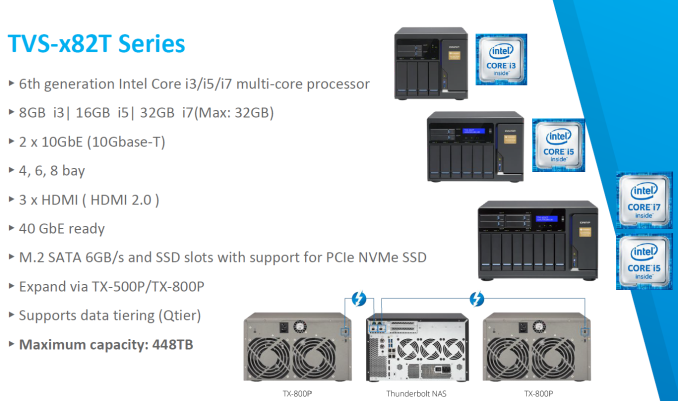
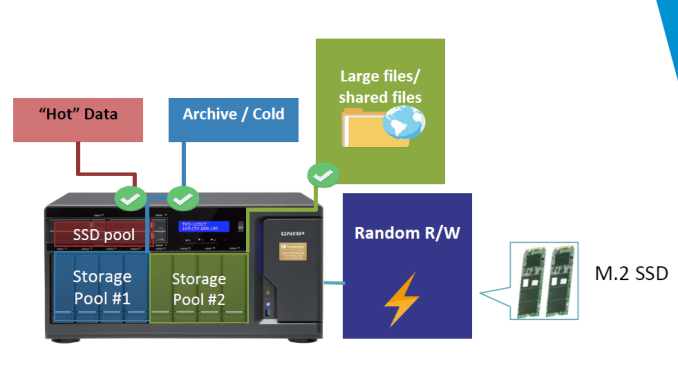
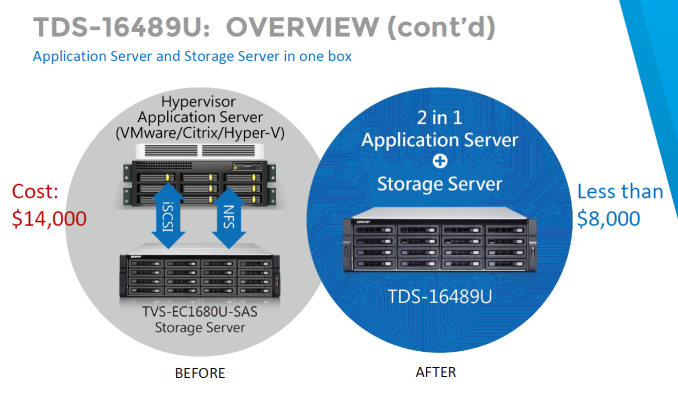
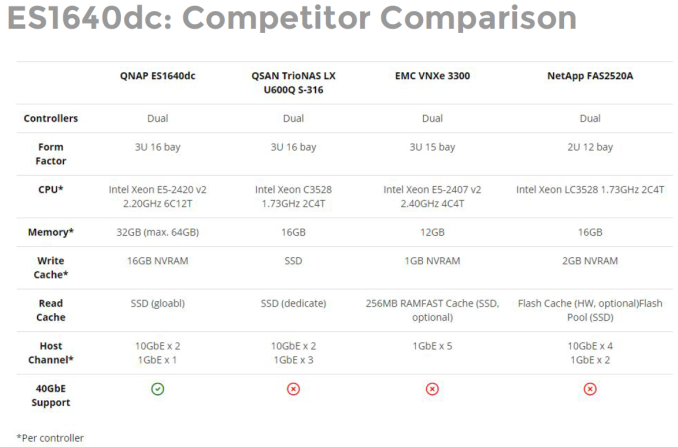
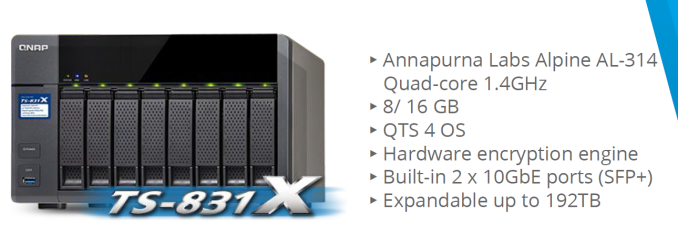








19 Comments
View All Comments
Dunkurs1987 - Tuesday, August 9, 2016 - link
You can do VM without Qnap soft, but this time is genuinely more about hardware. 3 tier system will squeeze every juice out of this box. PCI NVME slot can reward you with over 2000 Megabytes throughput speeds. Second tier SSD with 500 MB speeds and RAID storage at the bottom. Plus M.2 x2 slots for caching. Can not argue with that! Price for what you get is justified. http://www.span.com/product/Qnap-Desktop-NAS-10GbE...Space Jam - Saturday, May 14, 2016 - link
I'll be sticking to the recommendations and best practices as recommended by the devs and community, "yelling" or otherwise.Acquiring ECC is no price premium nor difficult for most people. The correct complaint is motherboards...
JoeyJoJo123 - Sunday, May 15, 2016 - link
Getting ECC ram isn't an issue. Getting on an ECC compatible platform is the issue. I can buy 16GB of ECC DDR3 no-big-deal, but my old gaming PC still isn't going to support using it. It's not just the motherboards being incompatible on ECC, it's the entire platform; needing server-grade processors that natively support ECC functionality, needing a motherboard that also supports ECC functionality, getting that ECC memory, and then (for some users) finding a motherboard that fits the size of the case you wanted to use.I wanted to use a Node 304 (miniITX) and the 6 hard drive cages for a relatively slim and compact FreeNAS box. When I made my build, nothing on the market supported what I needed for a reasonable price.
edward1987 - Tuesday, September 6, 2016 - link
I would go for i5 or i7 options for future proofing. But you can save some money by choosing less drives or just not filling all bays at very beginning. Price seems to start going down now http://www.span.com/search/IBQ-_star_82danjw - Saturday, May 14, 2016 - link
Last line, "a low lower", I think you meant "a lot lower".CalaverasGrande - Tuesday, May 17, 2016 - link
really enthusiastic about these boxes until I got to the THREE HDMI part. That just screams HTPC or whatever acronym they are using for ripping your movies to a box and playing them back on an HDTV.Professional content creators dont plug their source and program monitors into their storage. You could argue that it is a way to keep from tying up TB ports for displays, but editors, AE guys etc are more concerned about nosebleed fast storage. They dont want to give up even 10% bandwidth for a display or two.
I'm also a little skeptical about tiering. That works great on databases and even large photos. But when you are editing from prores 444 or 422, with hours of footage, that might be a problem for a deep cache. I hope the tiering doesnt eff up the speed of the unit for video editing by introducing latency.
ganeshts - Tuesday, May 17, 2016 - link
You can always disable Qtier and use ultra-fast SSDs in all the available slots :)HDMI ports, I would imagine, come in for free, and for scenarios involving playback of content directly on the NAS (a VM could help with that). I doubt it affects the bandwidth for the storage, since Skylake can support up to three separate display pipelines independent of the PCIe lanes.
David Harris - Tuesday, May 31, 2016 - link
Fully agree, these are beasts.!!!Would be a great solution if it had ECC, Thunderbolt 3 and USB-C as CORE architecture for the new breed NVMe SSD's from Samsung or Intel at circa 2,500 Mb/s (and M, and eventually Optaine at conservatively twice that, rather than core SATA
But I'm also old school EMC/HP and don't believe you should be playing media or running applications directly on the NAS, but having said that their Surveillance Station looks pretty interesting . . .
But they need to remember first and foremost it's a NAS
David Harris - Tuesday, May 31, 2016 - link
. . . was saying (M.2 - 4 lanes) . . .